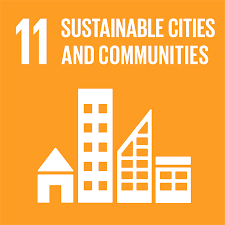Sustainable Architecture: The Road to Sustainability
- Yohanna

- Feb 25, 2021
- 4 min read
Updated: Mar 2, 2021
This article is focused on the following UN Sustainable Development Goals:
From the prosperous cities of the developed world to the less affluent cities of the developing world, buildings are constructed and continue to be essential to our living. The basic function of a building is to provide a structurally strong and stable environment to house and protect occupants and contents (Building Components). But to what extent is the construction of these buildings sustainable? The negative effects of the construction of buildings on our environment is surprisingly significant.
“According to new research by construction blog Bimhow, the construction sector contributes to 23% of air pollution, 50% of the climatic change, 40% of drinking water pollution, and 50% of landfill wastes. In separate research by the U.S. Green Building Council (USGBC), the construction industry accounts for 40% of worldwide energy usage, with estimates that by 2030 emissions from commercial buildings will grow by 1.8%” (Construction Impact Environment).

The construction of buildings is highly demanding of materials, some of which are harmful to the environment if used excessively or not disposed of properly. Many chemicals used at construction sites can significantly harm public health as well as the environment. Extraction of raw materials for use in construction also has a negative effect on the environment. In addition to this, heating, cooling and ventilation systems are often installed into buildings, and add to the overall building's energy consumption (Construction Impact Environment).
Construction activity has a significant impact on the surface of the land as well, due to the clearing of vegetation and excavating. Water supplies are heavily polluted as a result of construction. Additional research has shown that the production of materials commonly used in construction, such as concrete, aluminium and steel are responsible for large quantities of CO2 emissions (Construction Impact Environment).
Construction consumes around “half of all the resources extracted from nature, and accounts for one-sixth of global freshwater consumption, one-quarter of wood consumption, and one-quarter of global waste” (Construction Impact Environment). The construction of buildings also consumes a significant amount of energy, making construction poor and inefficient. This situation is made worse by the lack of effort seen from constructors to reduce the negative impacts of construction on the environment.
What is the solution to this problem?
Sustainable architecture provides a solution to the inefficiencies of current construction.
“Sustainable architecture is architecture that seeks to minimize the negative environmental impact of buildings by efficiency and moderation in the use of materials, energy, development space and the ecosystem at large. Sustainable architecture uses a conscious approach to energy and ecological conservation in the design of the built environment” (Sustainable Architecture).
Sustainable architecture is a growing concept that is gaining awareness due to its unique design and consciousness towards efficient energy and material use and towards the environment. Sustainable architecture uses methods to make heating, ventilation and cooling (HVAC) systems more efficient, uses renewable energy sources, and makes use of recycled and recyclable low-risk materials.

“The vegetation placed on the buildings corresponds to about two hectares of forest that help in the creation of a particular microclimate, producing humidity and oxygen and help the absorption of CO2 and fine dust" (Cima, Nicola).
Sustainable architecture can be applied in a number of ways making use of a number of different strategies. One strategy is to consider the climate of the building's area, and position windows in a way that will make it possible to maximize natural ventilation and make use of daylight. Some buildings also use high-efficiency HVAC systems to minimize carbon footprints. Another strategy is to use renewable energy systems. In this case, sources of renewable energy such as solar and wind are used to generate energy in place of fossil fuels. Green building materials are also a method of sustainable architecture.
Buying materials such as concrete and steel from manufacturing companies that are environmentally responsible as well as using recyclable materials is an aspect of sustainable architecture. Making efficient use of resources such as water and vegetation present in the location of the building also counts as a strategy to achieve sustainable building. Making sure water is used efficiently and not wasted by capturing rainwater and runoffs, and planting trees to provide cool shade instead of using energy-consuming cooling systems decreases environmental footprints (Top 6 Sustainable).

"By using passive solar heating and an extended roof of photovoltaic panels, these houses produce more energy than they consume" (Sustainable Residential).
Some of the above sustainable architecture strategies are simple and effective enough that people can implement them on smaller scales in their own living spaces. To save energy, it is best to have efficient HVAC installations as well as to make use of vegetation and not be dependent on energy-consuming electrical appliances. Installing solar panels to the roofs of houses as an alternative source of energy can significantly reduce carbon emissions.

When it comes to sustainability we can all make an impact. Every individual’s contribution counts. Making these small changes to our living areas, putting sustainable architecture strategies to use, as well as raising awareness of sustainable architecture’s important and significant contribution can have an influential impact. Let us take responsibility and do what we can to make our cities and communities sustainable.
Works Cited
"Building Components (Windows, Roofing, Siding, Sealants)." Exponent,
https://www.exponent.com/services/practices/engineering/buildings--
structures/capabilities/building-components-windows-roofing-siding-seala__/?
serviceId=5790ca7b-04f5-4bec-8d213263c21904e9&loadAllByPageSize=true&
knowledgePageSize=3&knowledgePageNum=0&n
ewseventPageSize=3&newseventPageNum=0&professionalsPageNum=1. Accessed 23
Feb. 2021.
Cima, Nicola. "Sustainable Architecture – Building Respecting the Environment." Comolake,
12 June 2020, comolakeimmobiliare.it/en/sustainable-architecture-building-respecting-
the-environment/. Accessed 25 Feb. 2021.
"How Does Construction Impact the Environment?" GoContractor, 21 June 2017,
gocontractor.com/blog/how-does-construction-impact-the-environment/. Accessed 23
Feb. 2021.
"Sustainable Architecture." Wikipedia, en.wikipedia.org/wiki/Sustainable_architecture.
Accessed 23 Feb. 2021.
"Sustainable Development Goals." UNDP,
www.undp.org/content/undp/en/home/sustainable-developmentgoals.
html#:~:text=The%20Sustainable%20Development%20Goals%20(SDGs,peace%20and
%20prosperity%20by%202030. Accessed 23 Feb. 2021.
"Sustainable Residential Design: Increasing Energy Efficiency." American Society
of Landscape Architects, www.asla.org/energyefficiency.aspx. Accessed 25 Feb. 2021.
"The Top 6 Sustainable Architecture Strategies for Public Building DesignHMC A." HMC
Architects, hmcarchitects.com/news/the-top-6-sustainable-architecture-strategies-for-
public-building-design-2018-10-03/. Accessed 23 Feb. 2021.






Comments